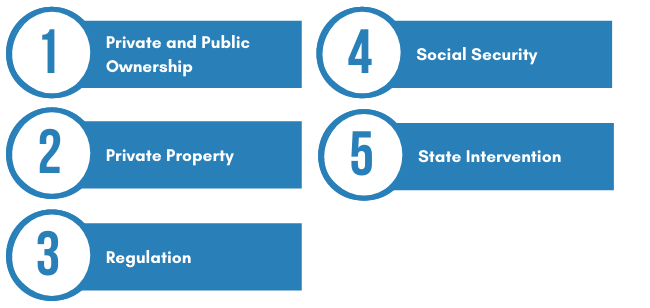Which Are Results Of Regulation In A Mixed Market Economy
Regulation plays a crucial role in a mixed market economy, ensuring fair competition, consumer protection, and social welfare. In this post, we will explore some of the key results of regulation in a mixed market economy, highlighting the significance of government intervention and oversight. From promoting market stability to preventing monopolies, regulation serves as a pivotal force in shaping the economic landscape.
1. Ensuring Fair Competition

One of the main objectives of regulation in a mixed market economy is to ensure fair competition among businesses. By setting rules and standards, regulatory agencies create a level playing field, preventing abusive practices, and promoting healthy market competition.
Through regulatory oversight, businesses are required to adhere to certain guidelines and practices, such as fair pricing, accurate advertising, and transparent operations. This enables consumers to make informed choices based on comparable options and encourages businesses to continually innovate to gain a competitive edge.
2. Protecting Consumer Rights

Consumer protection is a crucial aspect of regulation in a mixed market economy. Government intervention is necessary to safeguard the interests of consumers, ensuring the safety, quality, and fairness of products and services available.
Regulations often establish guidelines for labeling, packaging, and marketing practices to protect consumers from deceptive advertising or substandard products. Additionally, regulatory agencies work to resolve consumer complaints, investigate fraud, and enforce ethical business practices to maintain consumer trust and confidence.
3. Promoting Market Stability

Market stability is a key outcome of regulation in a mixed market economy. By monitoring and controlling market activities, regulatory authorities can prevent excessive price volatility, speculative bubbles, and disruptions that could undermine the overall economic health.
Regulations establish mechanisms to maintain a stable financial system by monitoring banking practices, controlling interest rates, and preventing fraud and abuse. Through oversight of financial markets, regulatory agencies play a vital role in ensuring the integrity and stability of the economy as a whole.
Frequently Asked Questions
Q: How does regulation benefit consumers in a mixed market economy?
A: Regulation benefits consumers by ensuring fair competition, protecting their rights, and promoting the availability of safe and high-quality products and services.
Q: What are some examples of regulatory agencies in a mixed market economy?
A: Examples of regulatory agencies include the Federal Trade Commission (FTC), Food and Drug Administration (FDA), and Securities and Exchange Commission (SEC).
Q: Is government regulation always beneficial in a mixed market economy?
A: While government regulation is essential for maintaining a balanced and fair economic environment, it should be carefully designed and implemented to avoid unnecessary burdens or stifling innovation.
In conclusion, regulation in a mixed market economy serves a vital role in ensuring fair competition, protecting consumer rights, and promoting market stability. Through oversight and enforcement, regulatory agencies play a critical part in shaping the economic landscape and safeguarding the interests of both businesses and consumers. By understanding the results of regulation, we can appreciate the importance of government intervention in creating and maintaining a robust mixed market economy.
Defining A Mixed Economy
 Image Source : www.academicdestressor.com
Image Source : www.academicdestressor.com economy mixed example definition cons features pros defining types economic system examples economics meaning slideshare advantages business introduction
Which Are Results Of Regulation In A Mixed Market Economy – DerivBinary.com
 Image Source : derivbinary.com
Image Source : derivbinary.com What Is A Mixed Economy? Pros, Cons And Examples - TheStreet
 Image Source : www.thestreet.com
Image Source : www.thestreet.com economy thestreet
Mixed Economy - Mixed Market
 Image Source : boelah.blogspot.com
Image Source : boelah.blogspot.com economy
🐈 England Mixed Economy. Reaching Britain With The Mixed Economy Of
What Is The Difference Between Capitalist Socialist And Mixed Economy
 Image Source : pediaa.com
Image Source : pediaa.com economy socialist quiz capitalist economies capitalism socialism ekonomi trivia pediaa exam coronavirus econ diketahui permasalahan komunis wajib proprofs understand consortiumnews
A Purpose Of Government Regulation In A Mixed-market Economy Is To
 Image Source : en.lifeder.com
Image Source : en.lifeder.com economy mixed market regulation purpose protect government system institutions laws implement consist markets legal these
A Purpose Of Government Regulation In A Mixed-market Economy Is To
 Image Source : academic.tips
Image Source : academic.tips economy mixed market purpose regulation government protect companydirectors aicd source au
Economy mixed example definition cons features pros defining types economic system examples economics meaning slideshare advantages business introduction. Economy socialist quiz capitalist economies capitalism socialism ekonomi trivia pediaa exam coronavirus econ diketahui permasalahan komunis wajib proprofs understand consortiumnews. Which are results of regulation in a mixed market economy – derivbinary.com. What is the difference between capitalist socialist and mixed economy. A purpose of government regulation in a mixed-market economy is to